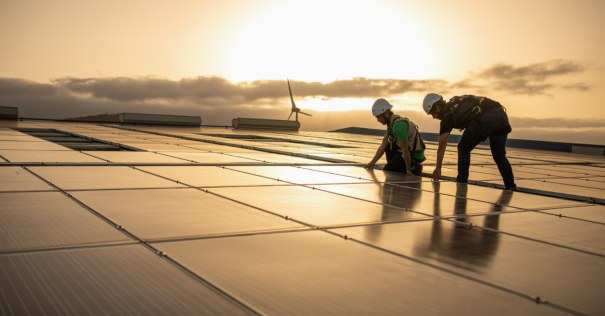
This article was originally published by Radio Free Asia and is reprinted with permission.
Operating solar and wind capacity in Southeast Asia grew in 2023 by a fifth, reaching over 28 gigawatts (GW), accounting for 9% of the total electricity generation capacity, a new report by Global Energy Monitor said.
The ASEAN countries, which include Brunei Darussalam, Cambodia, Indonesia, Laos, Malaysia, Myanmar, the Philippines, Singapore, Thailand, Vietnam, and Timor Leste, added 3 GW of solar capacity and 2 GW of wind power in 2023, according to GEM’s report.
However, it said that the slow pace in initiating new projects, combined with a difficult regulatory landscape for renewable energy and persistent dependence on fossil fuels, presents a significant challenge for achieving a transition to clean energy.
Despite having a substantial potential capacity of 220 GW in announced and various stages of construction projects, only a tiny fraction – 6 GW or 3% – is actively being constructed in Southeast Asia, according to the San Francisco-based think tank tracking global energy projects.
With the exception of China, which has the world’s largest and fastest renewables growth, the global average under construction is over twice that of ASEAN countries.
The ASEAN nations, known for their rapidly expanding economies, are experiencing a corresponding surge in energy demand, which has grown by a quarter between 2015 and 2021, much higher than the global average.
In November, the ASEAN Centre for Energy reported that the region has an installed power capacity of 310 GW, predominantly comprising coal, gas and hydropower, with capacities of 106.3 GW, 89.6 GW, and 61.2 GW, respectively.
The growth of renewable energy in 2022 was hindered by the prevalence of fossil fuel capacity, partly due to project delays caused by COVID-19 restrictions, resulting in a small shortfall from the ASEAN goal of a 35% renewable energy share in installed capacity by 2025.
This week’s report said ASEAN would have to build just 17 GW of utility-scale wind and solar capacity by 2025 to reach this goal, thanks to a large hydropower base.
In ASEAN, the potential for offshore wind power (124 GW) is nearly five times greater than that of onshore wind and almost double the global operating capacity for offshore wind (69 GW).
Vietnam leads the solar-wind power growth
The report revealed that Vietnam leads the region in operating utility-scale solar and wind capacity with 19 GW, followed by Thailand and the Philippines, each contributing 3 GW.
The Philippines and Vietnam, with prospective capacities of 99 GW and 86 GW respectively in solar and wind power, account for four-fifths of the region’s total. These figures place them as the eighth and ninth largest in terms of prospective capacity globally.
Laos is significantly outpacing its economic size in developing utility-scale solar and wind capacity, with over 3 GW prospective capacity, rivaling Thailand and surpassing Malaysia by over 150%, despite its much smaller economy, GEM said in its report.
Additionally, Laos is on track to host the region’s largest onshore windfarm, the Monsoon, which is under construction and projected to reach a capacity of 600 MW upon completion.
There are currently no utility-scale solar or wind projects in operation in Brunei, Laos, and Timor Leste, and none under construction in Indonesia, Cambodia and Brunei.
“The growth of renewables across the region is impressive, but so much more can be achieved,” said Janna Smith, researcher and lead author of the report.
“With the world now aiming to triple renewables capacity by 2030, governments need to make it easier to bring wind and solar power online. Switching to renewables now from coal and gas will save countries time and money on the path to a clean energy future.”
At the recent COP28 climate summit in Dubai, more than 120 governments agreed to triple global renewable capacity to at least 11,000 GW by 2030.
Only Thailand, Malaysia, Singapore, and Brunei signed the agreement from the ASEAN region, which is highly susceptible to climate change impacts, including flooding, drought, rising sea levels, and heat waves.
These challenges put pressure on electricity supplies amidst the region’s increasing energy demand.
According to GEM, fossil fuels remain entrenched in ASEAN, which has hampered new investment in utility-scale wind and solar, with coal-fired power capacity seeing 7% annual growth for the past seven years.
Experts have blamed insufficient grid infrastructure investment as a significant hurdle in the fast renewable rollout.
Earlier this week, Southeast Asia’s largest economy, Indonesia, announced plans to decrease the targeted share of renewables in the national energy mix from 23% to 17-19% by 2025, as coal-fired power plants remain a dominant energy source.
Last year, Indonesia saw its coal production reach a record high at 775 million metric tons, up from 687 million a year earlier, with more than two-thirds of it exported.
GEM said solar and wind power contribute to less than 1% of Indonesia’s total operating capacity, and while 19 GW are in development, none of this capacity is currently in construction.
0 comments :
Post a Comment